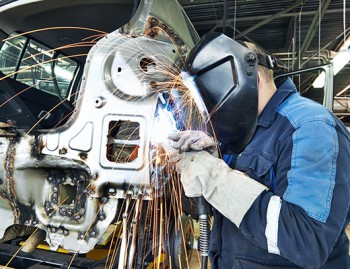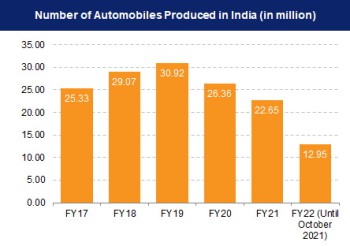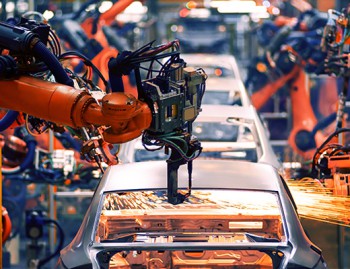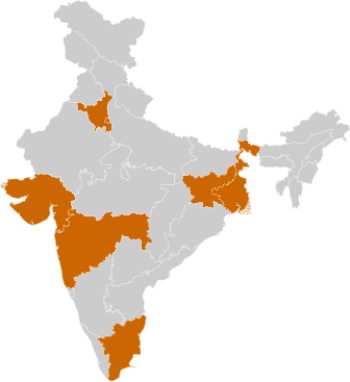INTRODUCTION
India’s annual production of automobiles in FY21 was 22.65 million vehicles, and 13 million vehicles were produced between April-October 2021.
The two wheelers segment dominates the market in terms of volume owing to a growing middle class, and a huge percentage of India’s population being young. Moreover, the growing interest of the companies in exploring the rural markets further aided the growth of the sector.
India is also a prominent auto exporter and has strong export growth expectations for the near future. In addition, several initiatives by the Government of India and major automobile players in the Indian market is expected to make India one of the leaders in the two-wheeler and four-wheeler market in the world by 2022.

MARKET SIZE

For the calendar year (CY) 2021, all segments showed growth, and total sales increased by 5.8% to 18.49 million units, compared to 17.47 million units in January-December 2020.
In CY21, passenger vehicles sales increased by 26.6% to 3.08 million units, up from 2.43 million units in CY20. The total number of commercial cars sold was 677,119, up 34% from 505,102 in the previous year.
In FY21, the total passenger vehicles production reached 22.65 million vehicles.
Two wheelers and passenger vehicles dominate the domestic Indian auto market. Passenger car sales are dominated by small and mid-sized cars. Two wheelers and passenger cars accounted for 81.21% and 14.56% market share, respectively, accounting for a combined sale of over 17.8 million vehicles in FY21.
In January 2022, total production of passenger vehicles*, three-wheelers, two-wheelers and quadricycles reached 1,860,809 units.
In December 2021, the luxury car market registered sales of 2,259 units, a YoY growth of 19.7%, with Mercedes Benz being the highest-selling luxury car manufacturer.
Passenger vehicle sales stood at 761,124 units for Q3 FY22.
Automobile exports reached 4.13 million vehicles in FY21, growing at a CAGR of 3.47% during FY16-FY21. Two wheelers (79.38%), passenger vehicles (9.79%) and three wheelers (9.52%) made up the majority of exports from India.
3680 premium motorcycles were sold in India in the year 2021. This was a 21% increase over the 2020 numbers.
In Q3 FY22, electric vehicle (EV) sales reached a new high of 5,592 units. Overall, in 2021, 329,190 EVs were sold in India, indicating a 168% YoY growth over last year’s sales of 122,607 units.
According to NITI Aayog and Rocky Mountain Institute (RMI), India’s EV finance industry is likely to reach Rs. 3.7 lakh crore (US$ 50 billion) by 2030. A report by India Energy Storage Alliance estimated that the EV market in India is likely to increase at a CAGR of 36% until 2026. In addition, projection for the EV battery market is expected to expand at a CAGR of 30% during the same period.
INVESTMENTS
To keep up with the growing demand, several auto makers have started investing heavily in various segments of the industry during the last few months. The industry attracted Foreign Direct Investment equity inflow (FDI) worth US$ 30.78 billion between April 2000-September 2021, accounting for 5.49% of the total equity FDI during the period.
Some of the recent/planned investments and developments in the automobile sector in India are as follows:
- In February 2022, a memorandum of understanding (MoU) was signed between electric two-wheeler company Ather Energy and Electric Supply Companies (ESCOMs) of Karnataka for setting up 1,000 fast charging stations across the state.
- In February 2022, Tata Power and Apollo Tyres Ltd announced a strategic partnership for the establishment of 150 public charging stations across India.
- In January 2021, leading commercial vehicle manufacturer Ashok Leyland teamed up with Aidrivers, a global leader in AI-enabled autonomous solutions for industrial mobility, to develop AI-enabled autonomous vehicles to fulfil the demands of a sustainable future.
- Two-wheeler EV maker HOP Electric Mobility, a diversified business venture of Rays Power Infra, is looking at investing Rs. 100 crore (US$ 13.24 million) over the next two years to expand manufacturing capacity for its EVs.
- In December 2021, TVS Motor Company and BMW Motorrad, announced a partnership in the two-wheeler EV space, with plans to release their first electric two-wheeler within the next two years.
- In December 2021, Hyundai announced plans to invest Rs, 4,000 crores (US$ 530.25 million) in R&D in India, with the goal of launching six EVs by 2028.
- In November 2021, Indian Oil Corporation (IOC) and two other public sector oil firms announced that they will install 22,000 EV charging stations in India over the next 3–5 years.
- In November 2021, Skoda Auto announced plans to locally manufacture electric cars in India. However, the firm may bring its first EV, the Enyaq, through the CBU route, before committing to local manufacturing.
- In November 2021, Hero Motor (HMC), the parent company of Hero Cycles, entered a joint venture partnership with Yamaha, a Japanese two-wheeler major, to make electric motors for e-bicycles for the global market.
- In October 2021, Tata Motors announced that private equity group TPG along with ADQ of Abu Dhabi has agreed to invest Rs. 7,500 crore (US$ 1 billion) in its EV division.
- A cumulative investment of Rs. 12.5 trillion (US$ 180 billion) in vehicle production and charging infrastructure would be required until 2030 to meet India’s EV ambitions.
GOVERNMENT INITIATIVES
The Government of India encourages foreign investment in the automobile sector and has allowed 100% FDI under the automatic route.
Some of the recent initiatives taken by the Government of India are -
- In February 2022, Mr. Nitin Gadkari, Minister of Road Transport and Highways, revealed plans to roll out Bharat NCAP, India’s own vehicle safety assessment program.
- In February 2022, 20 carmakers, including Tata Motors Ltd, Suzuki Motor Gujarat, Mahindra and Mahindra, Hyundai and Kia India Pvt. Ltd, were chosen to receive production-linked incentives (PLI) as part of the government's plan to increase local vehicle manufacturing and attract new investment. The 20 automobile companies have proposed a total investment of around Rs. 45,000 crore (US$ 5.95 billion).
- In the Union Budget 2022-23, the government laid out the following initiatives:
- The government introduced a battery-swapping policy, which will allow drained batteries to be swapped with charged ones at designated charging stations, thus making EV’s more viable for potential customers.
- India’s National Highways would be expanded by 25,000 km in 2022-23 under the Prime Minister’s Gati Shakti Plan.
- In November 2021, the Union Government added >100 advanced technologies, including alternate fuel systems such as compressed natural gas (CNG), Bharat Stage VI compliant flex fuel engines, electronic control units (ECU) for safety, advanced driver assist systems and e-quadricycles, under the PLI scheme for automobiles.
- In September 2021, the Union Minister for Road, Transport and Highways, Mr. Nitin Gadkari announced that government is planning to make it mandatory for car manufacturers to produce flex-fuel engines after getting the required permissions from the Supreme Court of India.
- In September 2021, the Indian government issued notification regarding a PLI scheme for automobile and auto components worth Rs. 25,938 crore (US$ 3.49 billion). This scheme is expected to bring investments of over Rs. 42,500 (US$ 5.74 billion) by 2026, and create 7.5 lakh jobs in India.
- In August 2021, Prime Minister Mr. Narendra Modi launched the Vehicle Scrappage Policy, which aims to phase out old polluting vehicles in an environmentally-safe manner.
- The Indian government has planned US$ 3.5 billion in incentives over a five-year period until 2026 under a revamped scheme to encourage production and export of clean technology vehicles.
- As of June 2021, Rs. 871 crore (US$ 117 million) has been spent under the FAME-II scheme, 87,659 electric vehicles have been supported through incentives and 6,265 electric buses have been sanctioned to various state/city transportation undertakings.
ACHIEVEMENTS
Following are Government’s achievements in the past four years:
- India enjoys a strong position in the global heavy vehicles market as it is the largest tractor producer, second-largest bus manufacturer, and third-largest heavy trucks manufacturer in the world.
- In September 2021, Power Grid Corporation of India Limited (POWERGRID) laid the foundation stone of the first EV charging station in Meghalaya at its office complex at Lapalang, Shillong.
- In July 2021, India inaugurated the NATRAX, which is Asia’s longest high-speed track and the fifth-largest in the world.
- Investment flow into EV start-ups in 2021 touched an all-time high, increasing nearly 255% to reach Rs. 3,307 crore (US$ 444 million).
- EV startups that attracted maximum funding in 2021 were Ola Electric (US$ 253 million), Blusmart (US$ 25 million), Simple Energy (US$ 21 million), Revolt (US$ 20 million) and Detel (US$ 20 million).
- Under NATRiP, following testing and research centres have been established in the country since 2015.
- International Centre for Automotive Technology (ICAT), Manesar
- National Institute for Automotive Inspection, Maintenance & Training (NIAIMT), Silchar
- National Automotive Testing Tracks (NATRAX), Indore
- Automotive Research Association of India (ARAI), Pune
- Global Automotive Research Centre (GARC), Chennai
- SAMARTH Udyog - Industry 4.0 centres: ‘Demo cum experience’ centres are being set up in the country for promoting smart and advanced manufacturing helping SMEs to implement Industry 4.0 (automation and data exchange in manufacturing technology).
ROAD AHEAD
The automobile industry is dependent on various factors such as availability of skilled labour at low cost, robust R&D centres, and low-cost steel production. The industry also provides great opportunities for investment and direct and indirect employment to skilled and unskilled labour.
Indian automotive industry (including component manufacturing) is expected to reach Rs. 16.16-18.18 trillion (US$ 251.4-282.8 billion) by 2026.
The Indian auto industry is expected to record strong growth in 2022-23, post recovering from effects of COVID-19 pandemic. Electric vehicles, especially two-wheelers, are likely to witness positive sales in 2022-23.

References: References: International Organization of Motor Vehicle Manufacturers, Media Reports, Press Releases, Department for Promotion of Industry and Internal Trade (DPIIT), Automotive Component Manufacturers Association of India (ACMA), Society of Indian Automobile Manufacturers (SIAM), Union Budget 2022-23
Disclaimer: This information has been collected through secondary research and IBEF is not responsible for any errors in the same
Agriculture Clusters
- Mumbai-Pune-Nashik-Aurangabad
- Chennai-Bengaluru-Hosur
- Delhi-Gurgaon-Faridabad
- Kolkata-Jamshedpur
- Sanand-Hansalpur-Vithalpur

Industry Contacts
- Automotive Component Manufacturers of India (ACMA)
- Society of Indian Automobile Manufacturers (SIAM)
- Automotive Research Association of India (ARAI)
- Automobile Association of Southern India (AASI)